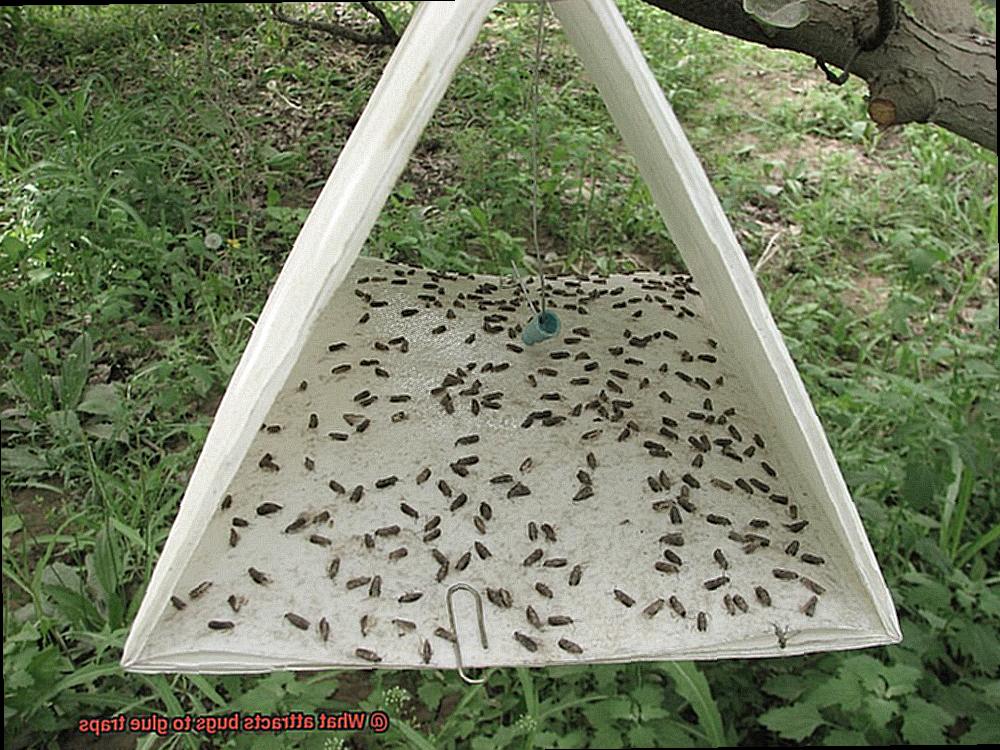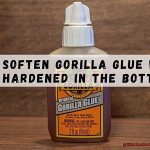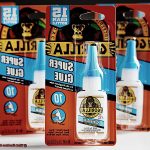Do you hate seeing those pesky bugs crawling around your home? If so, glue traps can be a convenient solution to catch them. But have you ever wondered what makes these sticky traps so irresistible to bugs?
It’s not as simple as you may think. Bugs are attracted to several factors that make glue traps an ideal trap for them.
Firstly, bugs are drawn to food, and leftover crumbs and spills can be a major draw for them. Glue traps can be placed strategically in areas around the house where food is commonly found, like the kitchen or dining room.
Additionally, bugs are naturally drawn towards moisture, which is why glue traps can also be used in bathrooms and basements or any place where there may be excess moisture.
Lastly, the chemical smells emitted by glue traps can also attract bugs. Some glue traps come with an attractant added to the sticky adhesive to make it more appealing to bugs.
If you’re wondering why your glue traps always seem to be full, now you know. Bugs are naturally attracted to food, moisture, and chemicals. Keep reading to learn more about what makes glue traps so irresistible to bugs and how you can use this effective pest control method in your home.
What are Glue Traps?
Contents
Glue traps are a widely used pest control method that rely on a strong adhesive to trap insects and rodents. These traps consist of a flat surface, often made of cardboard or plastic, that is coated with a sticky glue. They are typically placed along walls or in areas where pests are likely to roam, such as near food sources or in dark corners.
One of the major advantages of glue traps is their non-toxic nature. Unlike other methods of pest control that use harmful chemicals or poisons, glue traps are safer and more environmentally friendly. Furthermore, they are often less expensive than other options, such as mousetraps or insecticides.
However, there are some limitations to using glue traps. They may not be as effective for larger pests like rats or mice, and some people consider them inhumane since they leave insects or rodents stuck on the trap to suffer for an extended period before dying.
Despite these downsides, glue traps remain a popular and widely used method of pest control. They are particularly effective for smaller pests like cockroaches or spiders.
So how do these traps work? One key factor is the scent of the glue itself. Many glue traps contain pheromones or other attractants that mimic the scent of food or other insects. This smell can lure bugs in and make them more likely to land on the trap.
Additionally, bright colors like yellow and blue can mimic the appearance of flowers or fruit, which many bugs feed on. Rough or textured surfaces can also provide a good grip for bug’s feet, making it more likely for them to become stuck on the trap.
Moisture is another attracting factor for bugs to glue traps. Many insects require moisture to survive and if they detect moisture on or around a glue trap, they may be more likely to investigate it. Warmth can also be a lure for bugs since many insects are cold-blooded and require external sources of heat to regulate their body temperature.
The Attraction of Scent
Well, the answer lies in the power of scent.
Insects have an incredibly sensitive sense of smell that they use to locate food, mates, and shelter. This makes them highly susceptible to the scents used in glue traps. By mimicking natural food or pheromones, the scents in these traps can effectively lure pests into their sticky demise.
Each trap is specifically designed to attract a particular pest using scents that mimic its natural food or pheromones. For example, glue traps for cockroaches might have a scent similar to that of female cockroaches’ pheromones, which attracts male cockroaches to the trap. Similarly, glue traps for rodents may use a peanut butter scent that appeals to mice and rats.
But it’s important to note that not all insects are attracted to the same scents. Some pests may be repelled by certain scents while others are attracted to them. For instance, mosquitoes are drawn to carbon dioxide and lactic acid emitted by humans when they breathe, whereas ants and spiders might be repelled by these same smells.
Glue traps may be an eco-friendly way to catch pesky critters, but some people consider them inhumane since they leave the bugs stuck and suffering for an extended period before dying. As such, it’s crucial to use the right type of scent for the target pest.
The Attraction of Color and Texture
As an expert in the attraction of color and texture, I can tell you that these factors are essential to catching and removing unwanted insects from your living spaces.
Let’s start with color. Insects are highly attracted to bright colors, especially yellow. That’s why most glue traps are yellow – it’s a color that flies and other flying insects can’t resist. However, not all insects are attracted to the same color.
For instance, certain species of ants may prefer brown or red hues. Therefore, understanding which insects are common in your area and their preferences can help you choose a glue trap with the right color to effectively attract and catch them.
Now let’s talk about texture. The stickiness of the glue can mimic the texture of flowers or other natural surfaces that insects are naturally drawn to, making it more likely that they will land on the trap.
A slightly rough texture also attracts insects as it mimics the surface of leaves or other natural surfaces they prefer. However, not all insects are attracted to the same textures, so it’s important to know which textures will draw in the specific bugs you’re trying to catch.
Placement is also crucial when using glue traps. Placing them near areas where insects are commonly found, such as windows or doors, increases their chances of catching bugs. However, keep them away from areas where children or pets may come into contact with them as glue traps can be harmful if ingested.
The Attraction of Moisture
Bugs require water to survive and thrive, and they are constantly scouting for sources of moisture. Glue traps, with their sticky surfaces, can provide an attractive source of moisture for a wide variety of insects.
Damp environments are a breeding ground for many insects, such as cockroaches and silverfish. Areas like bathrooms and kitchens are often damp and attract these pests. The moisture in these areas can be a magnet for insects, and if there is a glue trap nearby, it’s highly likely that they will become trapped.
Moreover, food sources can also contribute to the attraction of moisture. Many insects feed on organic matter such as food scraps and crumbs, which can also attract moisture. If a glue trap is placed near a food source, it becomes even more enticing to insects.
It’s essential to note that not all insects are attracted to moisture in the same way. Some species, such as ants and flies, may be more attracted to food sources than to moisture. However, for many types of insects, the presence of moisture can be a powerful lure.
To maximize the efficiency of glue traps for insect control, it’s essential to consider where they are placed. By targeting areas with high levels of moisture such as bathrooms and kitchens, you can increase the chances of trapping a variety of insect species. Furthermore, keeping these areas clean and dry can help decrease the overall insect population in your home or business.
The Attraction of Warmth
The reason might be the attraction of warmth. Bugs are naturally attracted to warmth, perceiving it as a sign of potential food or shelter. Here are some reasons why warmth is a significant factor in attracting insects to glue traps:
- Heat Retention: The adhesive material used in glue traps retains heat, making them warm to the touch. This can be particularly appealing to bugs seeking warmth during colder months or in areas with air conditioning.
- Chemical Scent: Some insects are attracted to the scent of heated glue. When the glue is heated, it releases a chemical odor that can attract certain types of bugs. This scent can draw insects towards the trap, increasing the chances that they will become stuck.
- Nocturnal Insects: Nocturnal insects like cockroaches are more active at night and are often found in warm, dark places. Glue traps provide an ideal environment for these bugs seeking warmth.
So, if you want your glue traps to work effectively, make sure they’re warm enough. You can do this by placing them in warm areas of your home or using a heater to warm them up before placing them around your house. Understanding this attraction of warmth can help you better utilize glue traps and other pest control methods.
How to Maximize the Effectiveness of Glue Traps
Pesky bugs can easily invade your home, but using glue traps can be an effective solution. However, are you using your glue traps to their full potential? Here are five sub-sections to help maximize the effectiveness of your glue traps.
Proper Placement
Bugs are attracted to areas with food, moisture, and warmth. To catch the most bugs, place the traps in areas where bugs are likely to be found, such as near entryways, in corners, or along walls. Also, make sure not to obstruct the traps with any objects.
Using Multiple Traps
A single trap may not be enough to catch all the bugs. By using multiple traps in areas where you’ve seen the most activity, you increase your chances of catching more bugs. Be sure to check them regularly and replace them as needed.
Don’t Move the Traps
Once you have placed the traps, avoid moving them around too much. Bugs are more likely to walk over a trap if it has been in the same spot for a while, which increases your chances of catching them.
Keep Them Clean
Dirty traps are less effective at catching bugs. Clean them regularly and replace them when they become too full or damaged. Regular maintenance helps ensure that they remain effective.
Use Attractants
Some bugs are attracted to certain scents or pheromones. Adding these attractants to the trap can help lure them in and increase its effectiveness. For example, fruit flies are attracted to vinegar, so adding a small amount of vinegar to the trap can entice them.
Dispose of Used Traps Properly
Bugs that have been trapped on the glue can still be alive and may release pheromones that attract other bugs. To prevent this, seal used glue traps in a plastic bag before disposing of them in the trash. Proper disposal helps prevent further infestations.
Pros and Cons of Using Glue Traps
If so, you may have considered using glue traps as a way to control their populations. But before you rush out to buy a pack of these sticky traps, it’s important to weigh the pros and cons.
Let’s start with the pros. Glue traps are incredibly easy to use and require no setup or installation. Simply place them near entryways or in corners where pests are known to travel. They’re also affordable and can be found at most hardware stores or online. When used correctly, they can effectively trap and kill a variety of pests, from cockroaches to mice. And unlike some pesticides, glue traps are non-toxic and pose little risk to humans or pets.
However, there are also some cons to consider. One major downside is that glue traps can be inhumane. Trapped animals may suffer for hours or even days before eventually dying. This is why it’s important to check the traps regularly and dispose of them quickly if an animal is caught. Moreover, removing a trapped insect or rodent from the glue can be difficult and messy, especially if it gets stuck to their fur or feathers. Plus, larger pests like rats may be able to free themselves from the trap altogether. And let’s not forget that glue traps can be unsightly and may deter visitors if left out in the open.
So, what’s the verdict? Ultimately, whether or not to use glue traps for pest control is a personal decision that depends on your unique situation. Here are some things to keep in mind:
- Placement is key: Strategically place the traps near entryways or in corners where pests are known to travel.
- Use multiple traps: The more traps you use, the greater your chances of catching pests.
- Keep them clean: Dust and debris can interfere with the trap’s stickiness, so be sure to keep them clean.
- Add attractants: Some pests are attracted to certain scents, so consider using bait or pheromones to increase your chances of trapping them.
- Dispose of used traps properly: To prevent further infestations, dispose of used traps in sealed plastic bags.

Alternatives to Glue Traps
While glue traps may seem like a quick fix, they can be cruel and ineffective. Fortunately, there are plenty of alternatives that are just as effective and humane.
First, consider pheromone traps. These traps use natural insect pheromones to attract specific types of insects such as moths, fruit flies, and cockroaches. By using these traps, you can control pests without causing them harm or risking the safety of other animals.
Another option is to use natural insect repellents. These repellents contain ingredients such as citronella, peppermint, or eucalyptus oil that keep insects away. They can be used indoors and outdoors to keep your environment insect-free without any toxic chemicals.
Bait stations are another effective solution for controlling pests such as ants and roaches. These stations contain a food source mixed with a slow-acting insecticide which attracts pests and ultimately eliminates the entire colony. This is a great way to get rid of pests without having to handle them directly.
Physical barriers such as screens and mesh can also be used to keep flying insects out of your home or business. This is an especially useful solution for keeping mosquitoes and flies at bay during the summer months.
MGbH2dzR1Y0″ >
Conclusion
In summary, the humble glue trap is a cost-effective and reliable tool for pest control. Bugs are lured to these traps by various factors such as food, moisture, warmth, scent, color, and texture. However, it’s crucial to use the right scent for each target pest and place the traps strategically in areas where pests frequent.
Although glue traps have some drawbacks like being unsightly and inhumane, they remain a popular method of pest control. To get the most out of them, it’s essential to keep them clean, use multiple traps, add attractants if necessary, and dispose of used traps properly.
If you’re searching for humane and eco-friendly alternatives to glue traps that are just as effective, consider pheromone traps or natural insect repellents. Bait stations or physical barriers such as screens or mesh can also be useful.






